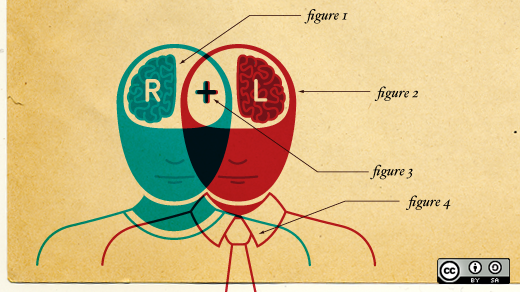Writing about collaborative, peer-to-peer teamwork in The Open Organization, Jim Whitehurst stresses the importance of:
- Encouraging team members to speak freely and honestly
- Encouraging team members be courageous enough to differ
- Selecting team members committed to achievement
- Selecting team members with the willingness to be accountable for a group's decisions
Those are four critical aspects of peer-to-peer work in open organizations, but they all presume something even more fundamental: that everyone on the team will get along.
You may know your teammates' knowledge, desire, experience, and skills, and you probably understand that all these things are important for the success of both the community and the goals you're striving to achieve—but that doesn't necessarily guarantee you'll work well with them. So, what do you do?
I've run into this problem before. For years, I've given vehicle sales seminars in more than 60 countries around the world, and I've experienced this problem in vehicle dealerships. Understanding cultural differences in each region, I struggled with ways I could help departments in the vehicle dealerships to collaborate more closely. (Specifically, I wanted to set up an interdepartmental introduction system that helped the Vehicle Sales Department, the Service Department and the Parts Department collaborate to increase customer satisfaction.) But, I couldn't get the departments to talk to each other.
Exploring personality types
Eventually, I discovered that each department had its own personality. People in sales tend to be very talkative; they like meeting lots of people every day. People in the Parts department like working with inventory numbers rather than people, as they forecast future demand. And people in the Service department like working with their hands, and quite often alone.
To get everyone working better together, I began studying personality types, prepared a presentation on them, and started giving seminars to dealerships jointly with these departments. Here, my main source of insight was the Myers-Briggs Type Indicator (MBTI), as it transcends cultural differences and seems applicable in any region of the world. I asked people in each department to determine their individual personality types, and then to categorize the personalities of their teams. Then, I instructed each department to share their types with the other departments.
It was a big success, and the dealership departments started to understand and cooperate with each other much more.
Putting personalities to work
Here's what worked for me: I think it's best to have people determine their preferences and personality types first.
For example, notice the below questions:
What energizes you and gets you excited?
- Are you a person who draws energy from the outside world of people, things, activities or interaction most of the time? (Keywords: external, outside thrust, talks out, thinks of many things, involved with people/things, interaction, action, do-think-do)
- Are you a person who draws energy from the internal world of ideas, emotions or impressions most of the time? (Keywords: internal, inside thrust, hold back on comments, thinks deeply of few things, involved with own thought, work alone, reserve, think-do-think)
People who identify with the first question (and set of key words) are mostly extraverts (E). People who identify with the second set are mostly introverts (I).
Where do you put most of your attention?
- Do you prefer to take in information through the five senses, noticing what is here and now most of the time? (Keywords: The five senses, what is real, practical, present orientation, facts, using established skills, utility, step-by-step)
- Do you prefer to take in information through a "sixth sense," noticing what might be most of the time? (Keywords: sixth sense, hunches, what could be, theoretical, future possibilities, insight, earning new skills, novelty, leap around)
People who identify with the first question (and set of keywords) prefer sensing (S). People who identify with the second set prefer intuition (N).
What do you value most when making a decision or judgment?
- Do you prefer organizing and structuring information and deciding in a logical, objective way most of the time? (Keywords: head, logical system, objective, justice, critique, principles, reason, firm but fair)
- Do you prefer organizing and structuring information to decide in a personal, value-oriented way most of the time? (Keywords: heart, value system, subjective, mercy, compliment, harmony, empathy, compassionate)
People who identify with the first question (and set of keywords) prefer thinking (T). People who identify with the second set are better at feeling (F).
What do you show outwardly most of the time?
- Do you prefer living a planned and organized life and are strong on decision making most of the time? (Keywords: plan oriented, regulate, control situation, settled, run one's life, set goals, decisive, organized)
- Do you prefer for living a spontaneous and flexible life and are strong on information gathering most of the time? (Keywords: spontaneous oriented, flow along, adapt to situation, tentative, let life happen, gather information, open, flexible)
People who identify with the first question (and set of keywords) prefer judging (J). People who identify with the second set prefer perceiving (P).
Armed with answers to the above questions, you can more easily determine your personality type. There are 16 types:
|
ISTJ |
ISFJ |
INFJ |
INTJ |
|
ISTP |
ISFP |
INFP |
INTP |
|
ESTP |
ESFP |
ENFP |
ENTP |
|
ESTJ |
ESFJ |
ENFJ |
ENTJ |
Once you're comfortable with your preferences and type, try to determine the type of that member in your group who's hard for you to work with. While working with that person, sprinkle a few strategic questions among project-related ones, so you can determine the personality type of the person working with you.
It's important to note that there is no "good" and "bad" type. Each has strengths (things those people are good at and like to use) and weaknesses (things those people are not so good at and don't like to use). To find out what those strengths and weaknesses are, you can read about each type.
Keep it confidential and flexible
As you make your determinations, you might consider keeping them confidential. I do this, for example, because I'm only observing someone in a single situation, and don't want them to think I'm letting that situation completely determine how I perceive them. Sometimes, people behave in ways they consider appropriate for the situation, even if that behavior conflicts with who they are at heart. Some bosses might believe they need to talk a lot in meetings, for instance, even though they are really very quiet people normally. Also, I like to continue to make observations even after I think I've determined a type, so I make adjustments as conditions (and people) change.
Manage your interactions
Now that you know your type and have a pretty good idea of others', you can start managing your behavior to achieve the best results. In most cases, other people in your organization will thank you for doing this, as you can help them by doing things they might not like to do (public speaking for the Introverts, for instance). In the end, it will make peer-to-peer discussions and decision-making far more productive.






12 Comments